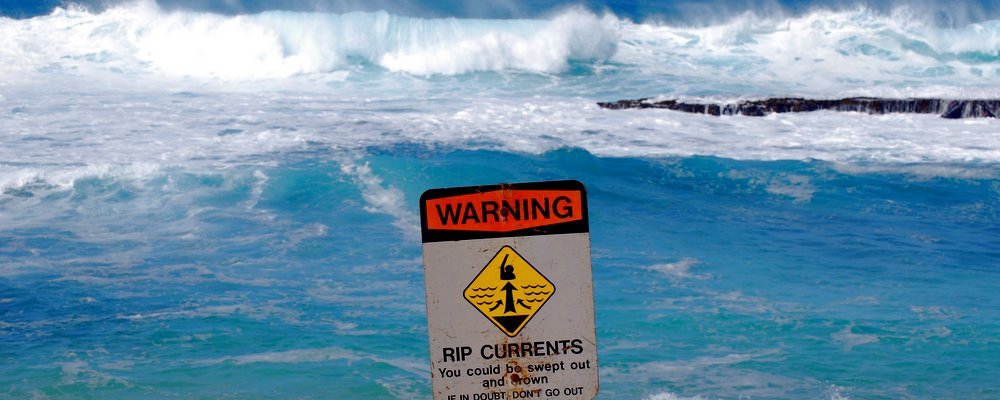Rip tides should strike fear in anyone who swims in the ocean. These potentially deadly currents kill more visitors to the beach than any other threat with over 100 drownings every year in the US blamed on rip tides. The United State Lifesaving Association reports that 80% of water rescues on beaches are due to rip tides, and this statistic is repeated worldwide. If you’re planning on swimming in the sea during your travels, swotting up on rip tides could save your life.
What are rip currents?
A rip current occurs when water being pushed up on the beach by breaking waves finds a channel that helps it return to sea more quickly, such as a gap in a sandbar. The water moving through this channel is much faster than the rest of the water flowing back to sea and becomes a rip current. Extremely dangerous to swimmers, if you’re caught in a fast-moving rip current you will be pulled out to sea. Many people refer to rip currents as ‘rip tides’, however this is a misnomer as a rip tide has different characteristics.
Where and when do rip currents occur?
Unfortunately, there are no set places or times when rips are more common. They can occur on any shoreline with waves, even on large lakes. Some beaches that have known gaps in sandbars or have structures such as piers or reefs have permanent rip currents that will be clearly marked on warning signs. But rip currents can occur anywhere, without warning, so making sure you know how to escape them is imperative for sea swimmers.
Why are rip currents dangerous?
The water rushing back out to sea through such a channel moves at speeds of up to eight feet per second – that’s faster than even the best swimmers in the world. If you try to fight against the current and swim back to shore, you will quickly become exhausted and be at risk of drowning if help does not arrive immediately.
How can I spot a rip?
This is the really scary bit: rip currents are notoriously hard to spot and they move, so they can be impossible to avoid. They can appear on any beach with waves and often create the illusion of calmer waters which unexperienced swimmers may mistake for a safe place to swim. There are several ways to spot rip currents, but this is not a fail-safe guide:
a) Look out for gaps in the waves. A calmer area of water surrounded by choppier waves is likely to be a rip.
b) Stay away from darker water. Rips can pick up sand and sediment, discolouring the water.
c) Avoid debris. Rips can also pick up seaweed and rubbish from the water, making them much easier to spot as the debris flows out to sea.

How can I avoid rip currents completely?
The only way to completely avoid rip currents is by not swimming in open water. However, most people will want to bathe in the sea during the summer months and shouldn’t be scared to do so. The best precautions that you can take are to only swim on beaches that have lifeguards on duty, swim between safety flags, pay attention to safety signs and never swim alone.
How can I escape a rip current?
The most important thing to remember if you are caught in a rip is not to panic. This is easier said than done if you suddenly find yourself being washed out to sea with a current that is impossible to fight, but if you panic and attempt to swim against the rip, you will quickly exhaust yourself.
Once you are up to your chest in water, it is likely that you will be pulled out by the current. If you are still in shallow water when you feel the pull, try to grind your feet into the sea bed and shout for help.
The most common advice for escaping a rip current is to swim parallel to the shore, rather than trying to swim against the flow. Rip currents are rarely over 100 feet wide and your best chance of escaping the flow is to swim sideways in either direction.
Once you have escaped the flow, you are likely to have used up your energy and could be very far from the shoreline. Alert the attention of someone on the beach as soon as possible by waving your arms and yelling, then tread water or float on your back until help arrives.
If the beach has no lifeguards, rest on your back to regain energy, then swim in a diagonal direction, away from the rip current towards the shore. It is important to swim diagonally to avoid finding yourself back in the rip. If at any time you feel tired, stop swimming and float while you get your breath.
What if I’m not a strong swimmer?
There is conflicting research that opposes the general consensus to swim parallel to escape a rip. Jamie MacMahan, a rip current expert at the Naval Postgraduate School in Monterey, California regularly subjects himself to rip tides in the name of research. MacMahan found that when he tried swimming parallel to the shore to escape a rip, it was often much easier to go in one direction that the other. This differed each time, but he realised that there is no way to know which direction is the best to swim in.
On up to 90% of the rips that he studied, MacMahan discovered that the currents flowed in huge circles, flowing out past the breakers before returning to shore. There is no way of knowing which way a circulating rip is flowing, so swimmers have a 50/50 chance that they’re swimming in the wrong direction.
From his research, MacMahon suggests that if you can relax and try to float, a circulating rip current will eventually take you back to the beach. However, conflicting research tells that these circulating rips are more common in certain areas than others, such as on the coast of California where MacMahon carried out his research. There is no way to tell if you are caught up in a ‘normal’ rip or a circulating rip, and if you decide to stop fighting and to float, you may simply be swept out to sea.
Emma Lavelle is a UK based writer and photographer and has her own blog Field and Nest.















